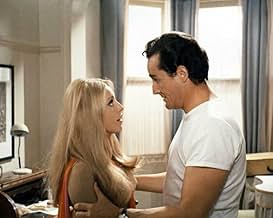Un giovane donnaiolo eredita tredici vecchie sedie logore e decide di venderle per ottenere dei soldi.Un giovane donnaiolo eredita tredici vecchie sedie logore e decide di venderle per ottenere dei soldi.Un giovane donnaiolo eredita tredici vecchie sedie logore e decide di venderle per ottenere dei soldi.
- Regia
- Sceneggiatura
- Star
Mylène Demongeot
- Judy
- (as Mylene Demongeot)
Grégoire Aslan
- Psychiatrist
- (as Gregoire Aslan)
Lionel Jeffries
- Randomhouse
- (English version)
- (voce)
Recensioni in evidenza
This film was cruising along quite nicely with Sharon Tate providing the best acting and the glamour
The moment Orson Wells arrived in the film .It suddenly lost its way .
For me .You can clearly see Sharon was going to be massive in years to come
I truly wish she had got the chance
Long unavailable, you can now (2011) buy this on DVD in an Italian release. No English subtitles but if you play the Italian subtitles you can work out what is happening. I wanted to see it for two reasons. First, I'm trying to watch all the various film versions of Ilf and Petrov's 1920s Soviet novel The Twelve Chairs. The plot - a man inherits a set of dining room chairs with jewels stashed in one of them, and a frantic chase ensues to find the right chair after the set has been dispersed - has been used various times, most notably by Mel Brooks in 1970. Second, the bizarre international cast seemed to indicate this was a really classic instance of international co-production of the type so common in the late 1960s. I was particularly interested, as a British viewer, to see stalwarts of 1970s British TV in an Italian-made film. What would the results be like?
After years of waiting, I was not disappointed.
In no other film will you see:
Willie Rushton declare his love for an ultra-camp Tim Brooke-Taylor - in dubbed Italian
Tim Brooke-Taylor camping it up with, in separate scenes, Orson Welles and Vittorio de Sica
Welles play Dr. Jekyll and Mr. Hyde as if in a pantomime
Terry-Thomas as a lorry driver.
Mylene Demongeot as a prostitute quite happy to hire out her chairs for men to make love with.
And so on and so forth. The film is typical of the late 60s kaleidoscope approach to film-making - throw every bizarre ingredient into the mix and see what happens, a la the original Casino Royale. But this film, while wildly dated, still entertains in a giddy sort of way, because it's fast-paced, there are no boring passages and you never (and I really mean never) know what will happen next.
If you like late 60s cinema, then this is a crucial watch. It is also valuable to watch if you are a student of British comedy, as you get two different comedy traditions - an older one music hall represented by Terry-Thomas on the one hand, and a newer TV satire one embodied by Rushton and Brooke-Taylor on the other - playing out in the context of an Italian film. It's really interesting to watch this if you are interested in the history of British comedy. I am pretty sure that no film historians writing such a history have included Twelve Plus One, but it deserves at least a side mention of British actors being used for international co-production purposes. The results are odd but fascinating.
I should also note that Ms. Tate is charming and certainly at the most beautiful I have seen her in any film. The tragedy of her early death is underlined by watching this film, where she does seem hugely magnetic. You do get a sense of why Polanski fell for her in real life.
Overall, Twelve Plus One is well worth seeing. It is a perfect time- capsule of what European films were like in the late 60s. It has a silly charm that still works today - in fact, the film may play better now, at forty years' distance, than it did when it was first released.
After years of waiting, I was not disappointed.
In no other film will you see:
Willie Rushton declare his love for an ultra-camp Tim Brooke-Taylor - in dubbed Italian
Tim Brooke-Taylor camping it up with, in separate scenes, Orson Welles and Vittorio de Sica
Welles play Dr. Jekyll and Mr. Hyde as if in a pantomime
Terry-Thomas as a lorry driver.
Mylene Demongeot as a prostitute quite happy to hire out her chairs for men to make love with.
And so on and so forth. The film is typical of the late 60s kaleidoscope approach to film-making - throw every bizarre ingredient into the mix and see what happens, a la the original Casino Royale. But this film, while wildly dated, still entertains in a giddy sort of way, because it's fast-paced, there are no boring passages and you never (and I really mean never) know what will happen next.
If you like late 60s cinema, then this is a crucial watch. It is also valuable to watch if you are a student of British comedy, as you get two different comedy traditions - an older one music hall represented by Terry-Thomas on the one hand, and a newer TV satire one embodied by Rushton and Brooke-Taylor on the other - playing out in the context of an Italian film. It's really interesting to watch this if you are interested in the history of British comedy. I am pretty sure that no film historians writing such a history have included Twelve Plus One, but it deserves at least a side mention of British actors being used for international co-production purposes. The results are odd but fascinating.
I should also note that Ms. Tate is charming and certainly at the most beautiful I have seen her in any film. The tragedy of her early death is underlined by watching this film, where she does seem hugely magnetic. You do get a sense of why Polanski fell for her in real life.
Overall, Twelve Plus One is well worth seeing. It is a perfect time- capsule of what European films were like in the late 60s. It has a silly charm that still works today - in fact, the film may play better now, at forty years' distance, than it did when it was first released.
The scene in the theater where Orson Welles plays Dr. Jekyll & Mr. Hyde is funny. Sharon Tate is sweet, but not as great as in "The Wrecking Crew." Mylène Demongeot is also funny in a very small role as a prostitute. There is another scene, very short, with Sharon Tate, Ottavia Piccolo and Vittorio Gassman, in bed, which would have been worth developing. Some great actors such as Orson Welles, Vittorio Gassman, Vittorio Di Sica, the English comedian Terry-Thomas, wasted in a sub-mediocre production.
I found this film delightful. It is frantic and fun but somewhat uneven in it's pacing. Vittorio Gassman is quite good as the poor schmuck who unknowingly gives away a fortunate hidden in one of thirteen chairs, and Sharon Tate is delicious in her role as the antique dealer. Had she lived, she may well have made it as a light comedian. It was quite surprising to see Orson Welles in this light comedy. His performance is more understated than the other two stars, but still quite good.
Barber in New York City inherits his great aunt's estate in Europe, but arrives only to find a run-down residence and thirteen matching chairs. Upon selling the chairs to a local antique store, he finds a note telling him that one of the chairs holds $100K under the yellow upholstery. Would-be screwball farce is missing most of its screws, however the cast is intriguing. This served as the final film of actress Sharon Tate before her murder in August 1969; if the movie is no longer very funny, at least we get a good look at this beauty near the end of her life. Tossing off quips and jumping into pools and beds, Tate is very frisky and cute, but hasn't much of a character to play. The narrative is so gloppy, we can't even be sure how other mercenary players find out about the hidden treasure, and lead Vittorio Gassman doesn't have the loose body language needed for an arms-flailing farce. Portions of the film are well-directed, though with so much cutting, over-dubbing, and globe-trotting, it isn't any wonder the picture leaves viewers exhausted and unsatisfied. ** from ****
Lo sapevi?
- QuizWhen Sharon Tate arrived in Rome for filming near the end of March 1969, she was about three months pregnant and beginning to show. Because the script called for several semi-nude scenes, the director arranged to film those scenes first. As filming (and her pregnancy) progressed, the director obscured Tate's stomach with large purses and scarves. This is most apparent in the scene following her ride in the furniture mover's van.
- Versioni alternativeBoth versions of the story (this one and Il mistero delle dodici sedie (1970)) have completely different opening and ending title sequences, in terms of fonts and placements. For example, in the opening in the former, the "12 + 1" logo appears one by one in the shot of Mario crossing the street, while in the other version, the logo appears 16 seconds into the film. The ending on the "12 + 1" version has the words "THE END" placed right before the end credits, and right after the freeze-frame, as opposed to the other version, that has "THE END" appear right after the end credits. In addition, both beginning and ending titles for the "12 + 1" version have names and companies that were not credited on the other version, and vice-versa. Both versions even feature different shots of the hair salon in the opening.
- ConnessioniFeatured in Charles Manson Superstar (1989)
I più visti
Accedi per valutare e creare un elenco di titoli salvati per ottenere consigli personalizzati
- How long is 12 + 1?Powered by Alexa
Dettagli
- Data di uscita
- Paesi di origine
- Lingue
- Celebre anche come
- Una su tredici
- Luoghi delle riprese
- Stafford Hotel, Londra, Inghilterra, Regno Unito(Pat and Mario's hotel while in London)
- Aziende produttrici
- Vedi altri crediti dell’azienda su IMDbPro
- Tempo di esecuzione1 ora 30 minuti
- Mix di suoni
Contribuisci a questa pagina
Suggerisci una modifica o aggiungi i contenuti mancanti

Divario superiore
By what name was Una su 13 (1969) officially released in Canada in English?
Rispondi





























